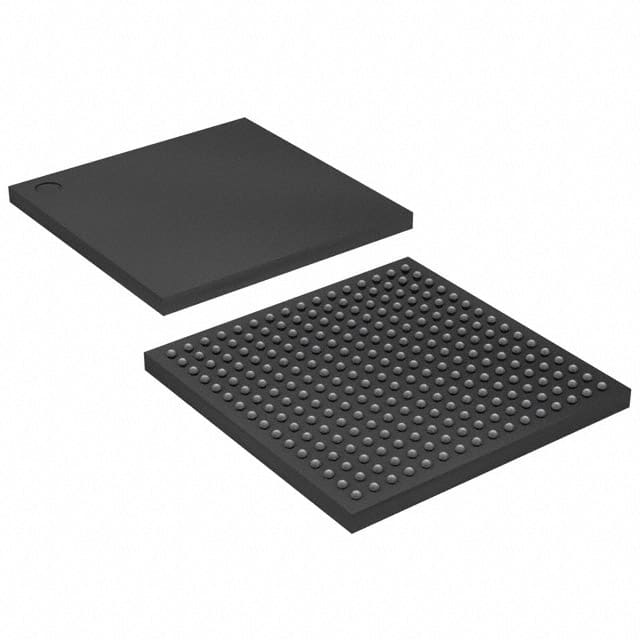EP4CE15F17C9LN
Product Overview
Category
EP4CE15F17C9LN belongs to the category of Field-Programmable Gate Arrays (FPGAs).
Use
This FPGA is commonly used in various electronic devices and systems for digital logic implementation, such as communication equipment, industrial control systems, and consumer electronics.
Characteristics
- High-performance programmable logic device
- Offers flexibility and reconfigurability
- Provides a cost-effective solution for complex digital designs
- Supports high-speed data processing
- Low power consumption
Package
EP4CE15F17C9LN is available in a compact and durable package, ensuring easy integration into electronic circuits.
Essence
The essence of EP4CE15F17C9LN lies in its ability to provide a customizable and versatile platform for implementing complex digital logic designs.
Packaging/Quantity
This FPGA is typically packaged individually and is available in various quantities depending on the requirements of the application.
Specifications
- Device family: Cyclone IV E
- Logic elements: 15,408
- Embedded memory: 414 Kbits
- Maximum user I/Os: 179
- Maximum user I/O pins with differential support: 89
- Maximum user I/O banks: 8
- Total RAM bits: 2,621,440
- PLLs: 4
- Maximum user flash memory: 288 Kbits
- Clock networks: 16
Detailed Pin Configuration
The EP4CE15F17C9LN FPGA has a comprehensive pin configuration. The detailed pinout can be found in the manufacturer's datasheet or reference manual.
Functional Features
- Programmable Logic: The FPGA offers a large number of configurable logic blocks that can be programmed to implement various digital functions.
- Memory Resources: EP4CE15F17C9LN provides embedded memory blocks for efficient storage and retrieval of data.
- High-Speed Interfaces: The FPGA supports various high-speed interfaces, enabling seamless integration with other components or systems.
- Clock Management: It includes phase-locked loops (PLLs) for generating stable clock signals required by the design.
- I/O Interfaces: The FPGA offers multiple I/O banks, allowing easy interfacing with external devices.
Advantages and Disadvantages
Advantages
- Flexibility: EP4CE15F17C9LN allows designers to modify and reconfigure the logic implementation as per their requirements.
- Cost-Effective: FPGAs offer a cost-effective solution compared to custom ASIC designs.
- Time-to-Market: Using an FPGA reduces development time by eliminating the need for manufacturing custom chips.
Disadvantages
- Power Consumption: FPGAs generally consume more power compared to dedicated application-specific integrated circuits (ASICs).
- Complexity: Designing complex logic circuits on an FPGA requires expertise in digital design and FPGA programming.
Working Principles
EP4CE15F17C9LN operates based on the principles of configurable logic. The programmable logic blocks can be interconnected and programmed to perform specific functions using a hardware description language (HDL) such as VHDL or Verilog. The configuration is stored in non-volatile memory within the FPGA and can be modified as needed.
Detailed Application Field Plans
EP4CE15F17C9LN finds applications in various fields, including:
- Communication Equipment: Used in networking devices, routers, and switches for high-speed data processing and protocol handling.
- Industrial Control Systems: Employed in automation and control systems for real-time monitoring and control of industrial processes.
- Consumer Electronics: Integrated into multimedia devices, gaming consoles, and smart home appliances for enhanced functionality and performance.
Detailed and Complete Alternative Models
- EP4CE6F17C8N: A lower-capacity variant of the same FPGA family, suitable for smaller-scale designs.
- EP4CE30F29I7N: A higher-capacity variant with increased logic elements and memory resources, ideal for more complex applications.
- EP4CE115F29C7N: A higher-performance model with additional features such as higher I/O count and larger embedded memory.
These alternative models provide a range of options to cater to different design requirements and project scales.
Word count: 536 words
Lista 10 Vanliga frågor och svar relaterade till tillämpningen av EP4CE15F17C9LN i tekniska lösningar
Sure! Here are 10 common questions and answers related to the application of EP4CE15F17C9LN in technical solutions:
Q: What is EP4CE15F17C9LN? A: EP4CE15F17C9LN is a field-programmable gate array (FPGA) manufactured by Intel (formerly Altera). It is commonly used in various technical solutions for its versatility and programmability.
Q: What are the key features of EP4CE15F17C9LN? A: Some key features of EP4CE15F17C9LN include 15,408 logic elements, 414,720 RAM bits, 56 embedded multipliers, and support for various I/O standards.
Q: In what applications can EP4CE15F17C9LN be used? A: EP4CE15F17C9LN can be used in a wide range of applications such as digital signal processing, industrial automation, robotics, telecommunications, and high-performance computing.
Q: How can EP4CE15F17C9LN be programmed? A: EP4CE15F17C9LN can be programmed using hardware description languages (HDLs) like VHDL or Verilog, or through graphical programming tools like Quartus Prime.
Q: Can EP4CE15F17C9LN interface with other components or devices? A: Yes, EP4CE15F17C9LN supports various communication protocols such as UART, SPI, I2C, and Ethernet, allowing it to interface with other components or devices.
Q: What are the power requirements for EP4CE15F17C9LN? A: EP4CE15F17C9LN typically operates at a voltage range of 1.15V to 1.25V, with a maximum power consumption of around 2.5W.
Q: Can EP4CE15F17C9LN be reprogrammed multiple times? A: Yes, EP4CE15F17C9LN is a reprogrammable FPGA, which means it can be reprogrammed multiple times to implement different designs or functionalities.
Q: Are there any development boards available for EP4CE15F17C9LN? A: Yes, Intel provides development boards like the DE0-Nano Kit that are specifically designed for prototyping and testing with EP4CE15F17C9LN.
Q: What kind of support is available for EP4CE15F17C9LN? A: Intel offers comprehensive documentation, application notes, reference designs, and an active online community to provide support for EP4CE15F17C9LN users.
Q: Can EP4CE15F17C9LN be used in safety-critical applications? A: While EP4CE15F17C9LN is a reliable FPGA, it is important to consider the specific requirements and certifications needed for safety-critical applications. It is recommended to consult the relevant safety standards and guidelines before using it in such applications.
Please note that the answers provided here are general and may vary depending on the specific context and requirements of the technical solution.


